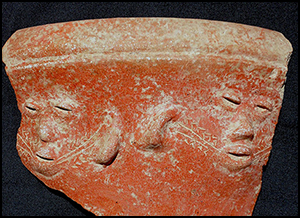Crossref Citations
This article has been cited by the following publications. This list is generated based on data provided by
Crossref.
2017.
First Islanders.
p.
267.
2017.
First Islanders.
p.
86.
Ono, Rintaro
Oktaviana, Adhi Agus
Ririmasse, Marlon
Takenaka, Masami
Katagiri, Chiaki
and
Yoneda, Minoru
2018.
Early Metal Age interactions in Island Southeast Asia and Oceania: jar burials from Aru Manara, northern Moluccas.
Antiquity,
Vol. 92,
Issue. 364,
p.
1023.
Carson, Mike T.
and
Hung, Hsiao-chun
2018.
Learning from Paleo-Landscapes: Defining the Land-Use Systems of the Ancient Malayo-Polynesian Homeland.
Current Anthropology,
Vol. 59,
Issue. 6,
p.
790.
McColl, Hugh
Racimo, Fernando
Vinner, Lasse
Demeter, Fabrice
Gakuhari, Takashi
Moreno-Mayar, J. Víctor
van Driem, George
Gram Wilken, Uffe
Seguin-Orlando, Andaine
de la Fuente Castro, Constanza
Wasef, Sally
Shoocongdej, Rasmi
Souksavatdy, Viengkeo
Sayavongkhamdy, Thongsa
Saidin, Mohd Mokhtar
Allentoft, Morten E.
Sato, Takehiro
Malaspinas, Anna-Sapfo
Aghakhanian, Farhang A.
Korneliussen, Thorfinn
Prohaska, Ana
Margaryan, Ashot
de Barros Damgaard, Peter
Kaewsutthi, Supannee
Lertrit, Patcharee
Nguyen, Thi Mai Huong
Hung, Hsiao-chun
Minh Tran, Thi
Nghia Truong, Huu
Nguyen, Giang Hai
Shahidan, Shaiful
Wiradnyana, Ketut
Matsumae, Hiromi
Shigehara, Nobuo
Yoneda, Minoru
Ishida, Hajime
Masuyama, Tadayuki
Yamada, Yasuhiro
Tajima, Atsushi
Shibata, Hiroki
Toyoda, Atsushi
Hanihara, Tsunehiko
Nakagome, Shigeki
Deviese, Thibaut
Bacon, Anne-Marie
Duringer, Philippe
Ponche, Jean-Luc
Shackelford, Laura
Patole-Edoumba, Elise
Nguyen, Anh Tuan
Bellina-Pryce, Bérénice
Galipaud, Jean-Christophe
Kinaston, Rebecca
Buckley, Hallie
Pottier, Christophe
Rasmussen, Simon
Higham, Tom
Foley, Robert A.
Lahr, Marta Mirazón
Orlando, Ludovic
Sikora, Martin
Phipps, Maude E.
Oota, Hiroki
Higham, Charles
Lambert, David M.
and
Willerslev, Eske
2018.
The prehistoric peopling of Southeast Asia.
Science,
Vol. 361,
Issue. 6397,
p.
88.
Halcrow, Siân E.
Crozier, Rebecca
Domett, Kate M.
Lertcharnrit, Thanik
Newton, Jennifer S.
Shewan, Louise G.
and
Ward, Stacey M.
2019.
Ethical Approaches to Human Remains.
p.
465.
Tabarev, A. V.
Patrusheva, A. E.
and
Cuevas, N.
2019.
Burials in Anthropomorphic Jars in the Philippines.
Archaeology, Ethnology & Anthropology of Eurasia,
Vol. 47,
Issue. 2,
p.
40.
Klamer, Marian
2019.
The dispersal of Austronesian languages in Island South East Asia: Current findings and debates.
Language and Linguistics Compass,
Vol. 13,
Issue. 4,
Pawlik, Alfred
Crozier, Rebecca
Fuentes, Riczar
Wood, Rachel
and
Piper, Philip
2019.
Burial traditions in early Mid-Holocene Island Southeast Asia: new evidence from Bubog-1, Ilin Island, Mindoro Occidental.
Antiquity,
Vol. 93,
Issue. 370,
p.
901.
O'Reilly, Dougald
Shewan, Louise
Domett, Kate
Halcrow, Siȃn E.
and
Luangkhoth, Thonglith
2019.
Excavating among the megaliths: recent research at the ‘Plain of Jars’ site 1 in Laos.
Antiquity,
Vol. 93,
Issue. 370,
p.
970.
Bulbeck, David
2019.
Encyclopedia of Global Archaeology.
p.
1.
Bellwood, Peter
2019.
The Spice Islands in Prehistory: Archaeology in the Northern Moluccas, Indonesia.
Jórdeczka, M.
Chłodnicki, M.
Sobkowiak-Tabaka, I.
and
Stanaszek, Ł.M.
2020.
Rebirth in the afterlife: Neolithic pot burials from Khor Shambat, Sudan.
Azania: Archaeological Research in Africa,
Vol. 55,
Issue. 1,
p.
44.
Bulbeck, David
2020.
Encyclopedia of Global Archaeology.
p.
6037.
Shipton, Ceri
O’Connor, Sue
Kealy, Shimona
Mahirta
Syarqiyah, Indah N.
Alamsyah, Nico
Ririmasse, Marlon
and
Zerboni, Andrea
2020.
Early ground axe technology in Wallacea: The first excavations on Obi Island.
PLOS ONE,
Vol. 15,
Issue. 8,
p.
e0236719.
Purnomo, Gludhug A.
Mitchell, Kieren J.
O’Connor, Sue
Kealy, Shimona
Taufik, Leonard
Schiller, Sophie
Rohrlach, Adam
Cooper, Alan
Llamas, Bastien
Sudoyo, Herawati
Teixeira, João C.
and
Tobler, Raymond
2021.
Mitogenomes Reveal Two Major Influxes of Papuan Ancestry across Wallacea Following the Last Glacial Maximum and Austronesian Contact.
Genes,
Vol. 12,
Issue. 7,
p.
965.
Samper Carro, Sofia C.
Stewart, Tahlia J.
Mahirta
Wood, Rachel
and
O'Connor, Sue
2021.
Burial practices in the early mid-Holocene of the Wallacean Islands: A sub-adult burial from Gua Makpan, Alor Island, Indonesia.
Quaternary International,
Vol. 603,
Issue. ,
p.
125.
Pugach, Irina
Hübner, Alexander
Hung, Hsiao-chun
Meyer, Matthias
Carson, Mike T.
and
Stoneking, Mark
2021.
Ancient DNA from Guam and the peopling of the Pacific.
Proceedings of the National Academy of Sciences,
Vol. 118,
Issue. 1,
McFadden, Clare
Walter, Richard
Buckley, Hallie
and
Oxenham, Marc F.
2021.
Temporal trends in the Colonisation of the Pacific: Palaeodemographic Insights.
Journal of World Prehistory,
Vol. 34,
Issue. 1,
p.
47.
O'Reilly, Dougald
Shewan, Louise
Khamphouvong, Mailo
Butphachit, Amphai
Luangkoth, Thonglith
Skopal, Nicholas
and
Bounxayhip, Souliya
2022.
Ban Pha Tai: The excavation and dating of a buried megalithic jar in Xieng Khouang, Lao PDR.
Archaeological Research in Asia,
Vol. 29,
Issue. ,
p.
100336.
